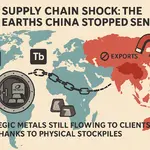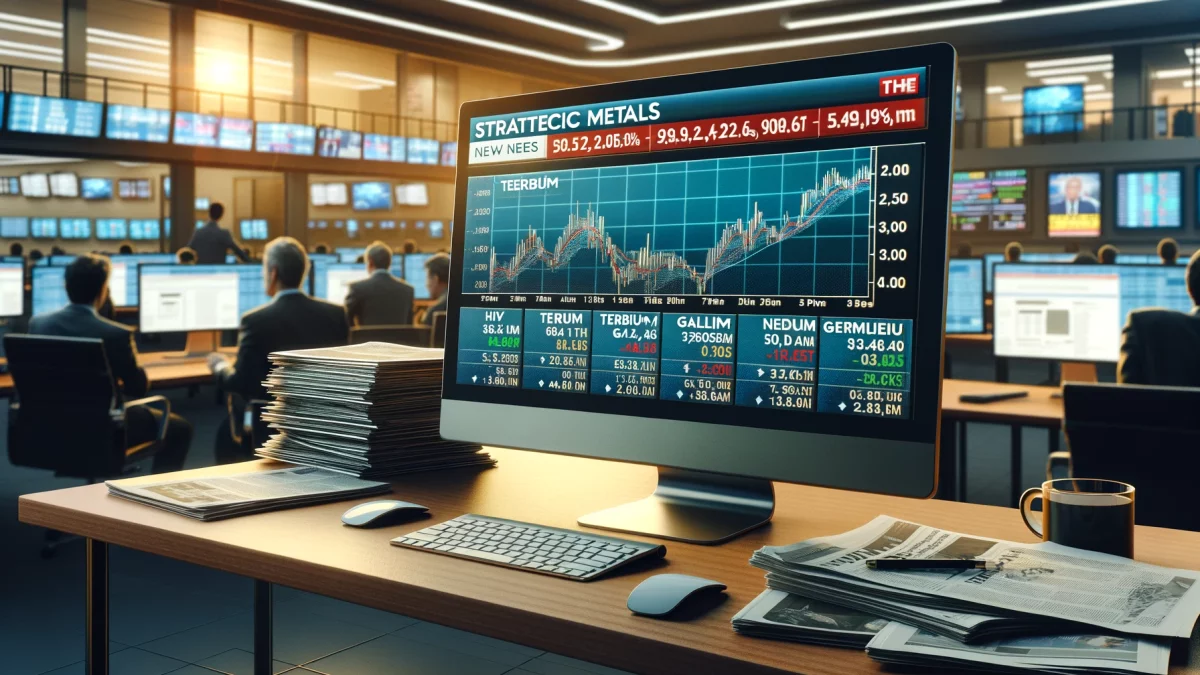
Weekly News Review June 9 – June 15 2025
June 15, 2025
Rare Earth Shortages Increase Gains for Private Investors
June 24, 2025China published the second batch of May export data, showing that shipments of the rare earth elements terbium and dysprosium fell to zero. Meanwhile, the Group of Seven leaders agreed to strengthen global critical mineral supply chains during their meeting in Canada this week.
All this and more in our weekly news round-up from the newsroom.
INDIA SEEKS TO HALT RARE EARTH EXPORTS TO JAPAN:
India has reportedly directed state-owned India Rare Earths Ltd (IREL) to suspend a long-standing export agreement with Japan, according to Reuters, citing unnamed sources. The deal, which has been in place since 2012, primarily involves the supply of neodymium, a key component used in high-performance magnets, to a Japanese trading house for processing and subsequent shipment to Japan. However, because a bilateral government agreement governs the exports, a complete suspension may not be immediate. Sources noted that IREL is expected to pursue a negotiated solution.
The move comes against the backdrop of China’s export controls on certain rare earth elements and related products, including magnets, which are crucial components in electric vehicles and other advanced technologies. According to The Times of India, especially the country’s automotive industry is awaiting relief from ongoing supply disruptions triggered by China’s tightening of rare earth exports.
India holds nearly 7 million metric tons of rare earth reserves, according to the U.S. Geological Survey, placing it among the top three globally. However, its mining output is dwarfed by global competitors. IREL, the country’s sole rare earth miner, has historically exported a significant portion of its production due to a lack of domestic processing capacity. That landscape is now shifting.
India Seeks to Benefit More from Its Critical Mineral Wealth:
In January, India’s Union Cabinet approved the National Critical Minerals Mission (NCMM), a nearly $2 billion initiative aimed at strengthening the country’s domestic capabilities in the exploration, processing, and recycling of critical raw materials. The program spans the entire value chain, encompassing both domestic development and international partnerships.
Earlier this year, Prime Minister Narendra Modi also urged Indian industries to move beyond raw material exports and develop midstream and downstream capabilities. He criticized the current dependence on importing finished goods made from India’s raw materials, calling the practice “unacceptable” for a growing economy.
GERMANY: IMPLEMENTATION OF STRATEGIC METALS FUND FACES FURTHER DELAYS:
Germany’s heavy reliance on imported specialty raw materials has come under increasing scrutiny in recent years. Trade restrictions on critical elements, such as gallium and germanium, and, more recently, certain rare earths, have exposed vulnerabilities in the country’s industrial supply chains.
To mitigate these risks, the German government launched a Raw Materials Fund intended to support projects focused on the extraction, processing, or recycling of critical resources. These projects aim to diversify supply networks and would be eligible for state-backed financial assistance.
While the fund was first announced in April 2023 and officially launched in October 2024, its implementation is stalled. According to Spiegel Online, no consulting firm has yet been appointed to evaluate proposed investment projects. The tender process for this role began under the previous federal government, but a final decision was postponed until after the snap federal election, according to the outlet.
This is not the first setback for the Raw Materials Fund. The entire initiative was initially in jeopardy due to unresolved funding questions. Later, disagreements among responsible ministries further delayed progress.
A budget of €1 billion supports the fund. Under the plan, the state-owned development bank KfW will make equity investments in raw material projects both domestically and abroad on behalf of the federal government. The focus is strictly on critical and strategically significant raw materials as defined in the EU’s Critical Raw Materials Act (CRMA).
G7 LEADERS AGREE TO STRENGTHEN STRATEGIC METALS SUPPLY CHAINS:
The leaders of the Group of Seven (G7) have provisionally agreed on a strategy to bolster the resilience of critical mineral supply chains, according to media reports. A draft statement seen by Reuters emphasizes diversification, increased investment, and the need for markets to reflect the actual costs of responsible extraction, processing, and trade.
Although the draft does not explicitly name China, it emphasizes the economic risks posed by non-market policies and practices in the sector, describing them as a “threat to our economies.”
China dominates many critical mineral supply chains, particularly in the processing stages, leaving other countries highly dependent on its exports. This reliance was highlighted in April when Beijing imposed export restrictions on a range of rare earth elements and related products, a move widely seen as retaliation against newly imposed U.S. trade tariffs. It followed similar actions in 2023 when China restricted exports of the critical metals gallium and germanium.
While the G7 has launched various initiatives on critical minerals in recent years, these efforts remain limited in scale and fall short of meaningfully challenging China’s dominance, according to the U.S. think tank Center for Strategic and International Studies (CSIS).
In 2023 alone, China invested more than $16 billion in overseas mining projects, compared to the G7’s collective commitment of just $13 billion to critical mineral initiatives. CSIS also notes that China maintains a strategic advantage by controlling the entire value chain, from extraction and processing to the production of finished goods, whereas G7 efforts tend to focus on isolated segments of the supply chain.
JAPAN SEEKS NEW RARE EARTH SUPPLY SOURCES:
Rare earths from Angola, refined in India, destined for Japan.
Mining company Pensana and Toyota Tsusho, a trading arm of the Toyota Group, have signed a non-binding memorandum of understanding (MoU) for the supply of rare earth elements. Under the agreement, up to 20,000 tonnes of mixed rare earth carbonate from Pensana’s Longonjo mine in Angola could be supplied annually for further processing to Toyota Tsusho’s subsidiary, Toyotsu Rare Earth India, which has been operating a refinery in India since 2013.
In addition to a supply agreement, both parties are exploring further collaboration opportunities throughout the entire rare earth value chain. The Longonjo project, owned by the UK-based Pensana, is currently under construction.
Should a binding agreement follow, Toyota Tsusho would strengthen its position against potential disruptions from its existing supply channels in India. Recent reports suggest that the Indian government may have directed India Rare Earths Limited (IREL), a state-owned mining company, to suspend a 13-year-old export agreement with Toyotsu.
India, a rare earth producer itself, is reportedly aiming to stockpile critical resources and expand domestic processing capabilities to secure its supply chain. However, no official confirmation of such government action has been issued so far.
CHINESE EXPORTS OF DYSPROSIUM AND TERBIUM PLUMMET TO ZERO IN MAY:
The People’s Republic imposed export license requirements in April.
Chinese customs authorities have released the second batch of May export data, revealing that exports of the rare earth elements dysprosium and terbium fell to zero. This marks a significant development following the introduction of new export licensing requirements on April 4.
Under the updated rules, exporters must obtain licenses to ship these two elements, as well as five other rare earths and their compounds, outside of the country. Exports had already begun to decline in April, but May’s figures reflect the full impact of the licensing regime.
A similar measure was enacted in mid-2023 for the strategic metals gallium and germanium. In the aftermath, exports stopped completely for roughly two months. At that time, Chinese authorities estimated the licensing process would take approximately 45 working days, suggesting a potential timeline for future export license measures.
Dysprosium and terbium are crucial for various high-tech industries, including semiconductor manufacturing and chemical processing.
However, their most important use lies in the production of neodymium-iron-boron (NdFeB) magnets. While not all NdFeBs contain dysprosium or terbium, these elements are crucial additions in magnets designed for high-performance and high-temperature environments, such as those found in electric vehicle (EV) motors, wind turbines, and advanced defense technologies.
Both elements are so-called heavy rare earths, a subgroup of rare earth elements with a minimal global supply. Production and refining are heavily concentrated in China and its neighboring country, Myanmar, with only negligible output elsewhere, leaving global industries highly exposed to shifts in Chinese export policy.
PLATINUM PRICE HITS TEN-YEAR HIGH:
Strong Demand from the Jewelry Sector Drives Surge in Prices.
The price of platinum temporarily climbed to a ten-year high this week. In early trading on Thursday, the precious metal was quoted at nearly $1,350 or €1,150 per ounce.
The platinum market is currently in a supply deficit, with demand outstripping available supply. According to the World Platinum Investment Council, one key factor is the decline in investment in mining operations, driven by relatively low prices for platinum group metals over the past year.
This structural deficit is expected to persist through 2029, particularly as demand may grow faster than previously forecast, primarily fueled by increased investment purchases in China.
Rising demand from the jewelry industry is also playing a significant role in supporting prices.
CHINESE RARE EARTH MAGNET EXPORTS PLUNGE IN MAY:
China’s rare earth magnet exports have sharply declined in recent months following the government’s decision to impose export controls on specific rare earth elements and related products. The new restrictions apply to elements including terbium and dysprosium, which are used in some, but not all, neodymium-iron-boron (NdFeB) magnets.
These particular elements are crucial additions to magnets that must maintain high performance and stability under elevated temperatures, such as those used in electric vehicle motors and wind turbines.
However, customs authorities in Beijing currently use a single tariff code for all rare earth magnets, regardless of whether they contain the restricted materials. This lack of differentiation has caused widespread delays in shipments, according to industry experts.
According to data from the customs authorities, China exported just 1,238 tons of rare earth magnets in May, marking the lowest monthly volume since early 2020 and representing a 74% year-over-year decrease.
Exports in April had already fallen by half compared to March. While Chinese authorities have recently issued a limited number of export licenses, the overall supply remains significantly constrained.
The top three destinations for Chinese rare earth magnet exports in May were Vietnam (235 tons), Germany (209 tons), and India (150 tons). In contrast, only 46 tons were shipped to the United States, down from 689 tons during the same month in the previous year. This marks a year-on-year decline of approximately 93 percent.
Figure of the Week: 3% – of all the gold ever mined throughout human history is stored in the vaults of the Federal Reserve Bank in New York City.






